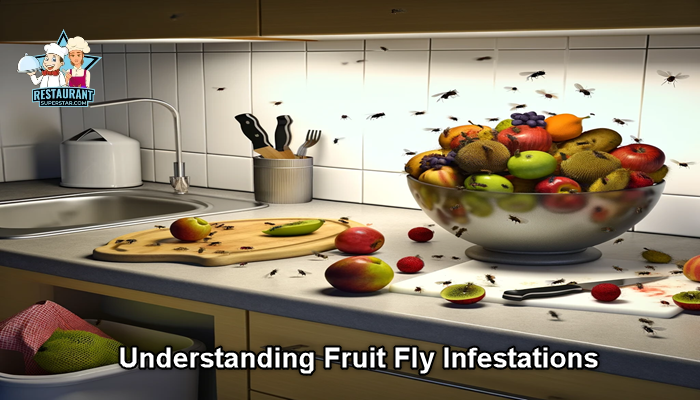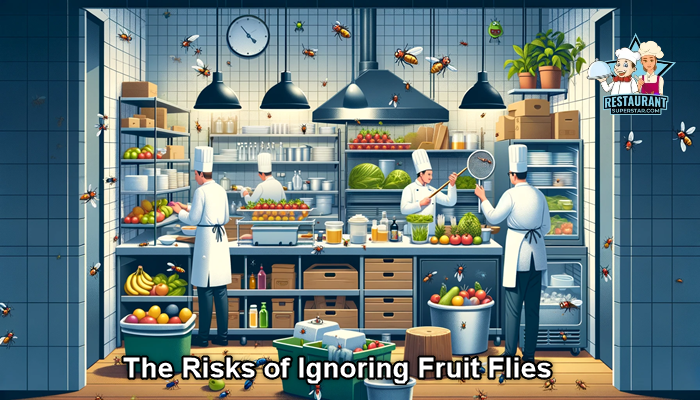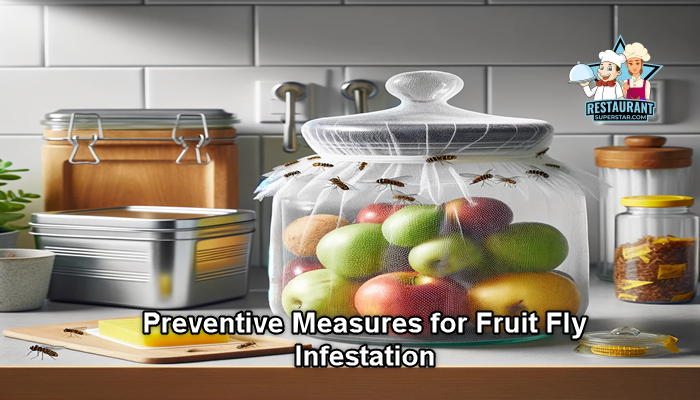How to Get Rid of Fruit Flies in Restaurants
You are in the right place; if you’re struggling with fruit flies in your restaurant, you’ve come to the right place.
Our article effectively solves your problem and covers other essential topics you want to take advantage of.
Get ready to eliminate fruit flies and improve the overall cleanliness of your restaurant.
This article will cover this and other important questions, revealing some game-changing tips to keep your establishment pest-free and your customers happy.
How to Get Rid of Fruit Flies in Restaurants?
Combining thorough cleaning practices with targeted eradication strategies is crucial to swiftly and effectively rid your restaurant of fruit flies. Whether removing food attractants, using drain gels, or employing insecticides, the key lies in a holistic approach.
But here’s a twist: it’s not just about eliminating what’s visible; you need to understand their breeding habits, identify their favorite hideouts, and take preemptive measures to prevent future infestations.
This article delves deep into fruit fly control, offering practical, easy-to-implement solutions tailored for new restaurant owners, young chefs, and anyone grappling with this pesky problem.
Stay with us as we explore the ins and outs of How to Get Rid of Fruit Flies in Restaurants? You’re about to discover more than just the basics – you’re stepping into a realm of expert advice that will transform your restaurant into a no-fly zone!
1 – Understanding Fruit Fly Infestations

The Attraction Factor
Let’s dive into what brings fruit flies into your restaurant or bar. You might be surprised that these tiny invaders are not just random visitors; they’re attracted to specific things in your establishment.
Understanding this is your first big step in the journey of how to get rid of fruit flies in restaurants.
1 – Ripe and Overripe Fruits and Vegetables
Yes, the main culprits! Fruit flies have a thing for ripe, fermenting, or rotting fruits and veggies. They’re not picky eaters, so your kitchen’s fresh produce is like an all-you-can-eat buffet for them.
2 – Moist Environments
These flies are all about moisture. They’re drawn to any damp area, which makes places like sink drains, mops, and even damp rags in your kitchen their perfect breeding grounds.
3 – Leftovers and Food Scraps
Fruit flies aren’t shy about feasting on your leftovers. Food scraps, especially those containing sweet or fermented elements, are a big draw.
4 – Garbage Bins
The smell of garbage can be irresistible to fruit flies. If your bins aren’t sealed or cleaned regularly, they become a fruit fly paradise.
5 – Alcohol and Sugary Drinks
In bars, those sticky residues from alcoholic beverages and sweet drinks are like a VIP invitation for these pests.
Here’s a quick tip for all new restaurant owners and young chefs: Regularly check and clean the areas where these attractants are found.
It’s not just about keeping your space clean; it’s about being innovative with your sanitation practices to prevent these little guys from making themselves at home.
Remember, getting rid of fruit flies in your restaurant isn’t just about dealing with them after they’ve arrived; it’s about cutting off their reasons for visiting in the first place.
Breeding and Life Cycle
Now that we’ve covered what attracts fruit flies to your establishment, let’s discuss their breeding and life cycle. This might sound a bit technical, but trust me, it’s fascinating – and crucial for understanding how to get rid of fruit flies in restaurants.
1 – The Start – Egg Laying
Female fruit flies are pretty busy moms. They lay their eggs on the surface of ripe or fermenting fruits and vegetables. And we’re not talking about just a couple of eggs. A single female can lay up to 500 eggs!
2 – From Egg to Larva
These eggs hatch into larvae in just about 30 hours. Larvae, which look like tiny white worms, immediately start feeding on the fruit they were born on. This is where they get all the nutrients they need to grow.
3 – The Pupa Stage
After feeding for a few days, these larvae mature into pupae. This is a transition phase where they start developing into adults. The pupa stage can last anywhere from four to six days.
4 – Adult Fruit Flies
Finally, they emerge as adults, ready to start the cycle again. The scary part? This process can happen in just a week, from egg to adult!
5 – Short Lifespan, High Impact
Adult fruit flies don’t live very long – typically only a week or two. But in that short lifespan, they can wreak havoc in your restaurant or bar because of their rapid breeding cycle.
Here’s a pro tip, especially for new restaurant owners and young chefs: Understanding this life cycle is key.
If you see adult fruit flies, there are likely breeding grounds nearby. Tackle these areas immediately to interrupt their life cycle and prevent a full-blown infestation.
Our next section will explore the risks of ignoring fruit fly problems. So keep reading to arm yourself with all the knowledge you need to maintain a fruit fly-free environment in your restaurant.
1c – Common Breeding Grounds in Restaurants
Identifying and tackling the typical breeding grounds of fruit flies in your restaurant is vital in answering the pressing question of how to get rid of fruit flies in restaurants. Let’s shed some light on their favorite hideouts:
Garbage Bins
These are like luxury hotels for fruit flies. Leftover food, especially fruits and vegetables, provides a perfect breeding spot. Regularly emptying and sanitizing your bins is a must.
Drains and Sink Areas
Your kitchen and bar drains can be a fruit fly paradise. Why? Because they’re often damp and have bits of food waste that fruit flies can feed on. Regular cleaning and use of drain gels can be a game-changer here.
Mops and Cleaning Rags
Wet and dirty mops or rags are often overlooked as breeding grounds. Keep them clean and dry to avoid turning them into a fruit fly nursery.
Unused Equipment
Any seldom-used equipment or containers that are not adequately cleaned can accumulate organic matter, attracting fruit flies. Regular checks and cleaning are crucial.
Fruit Storage Areas
Overripe or damaged fruits in storage areas are a big draw. Regular inspection and proper storage methods can help mitigate this risk.
Recycling Bins
These are often neglected, but sugary residues from cans and bottles are like a magnet for fruit flies.
Bar Areas
Spills from sweet or alcoholic beverages can attract fruit flies if not cleaned properly. Ensuring a thorough clean-up after each shift is essential.
For you, the new restaurant owners and young chefs, it’s essential to understand that if left unchecked, these breeding grounds can quickly escalate a minor fruit fly problem into a full-blown infestation.
Regular monitoring and maintenance of these areas can significantly reduce the chances of fruit fly problems in your establishment.
In the next section, we’ll delve into the risks associated with fruit fly infestations and why it’s crucial to remember these tiny pests.
2: The Risks of Ignoring Fruit Flies

Health Hazards
Ignoring fruit flies in your restaurant is not just about dealing with a minor nuisance; it’s about safeguarding the health of your customers and staff. Let’s unpack the health risks associated with these tiny pests, underlining the importance of the query of how to get rid of fruit flies in restaurants.
1 – Pathogen Carriers
Fruit flies can carry and spread bacteria and other pathogens. They often travel between unsanitary areas (like trash bins) and food surfaces, becoming vectors for disease.
2 – Contamination of Food
These flies can contaminate food by transferring harmful microorganisms. Imagine a fruit fly visiting a garbage bin and landing on your freshly prepared dishes – not a pleasant thought!
3 – Risk of Foodborne Illnesses
Some of the bacteria fruit flies carry, like E. coli, Salmonella, and Listeria, are notorious for causing foodborne illnesses. These can range from mild stomach upsets to severe health complications, especially in vulnerable groups like the elderly and young children.
4 – Compromising Food Safety Standards
In the culinary world, reputation is everything. Fruit flies can compromise your restaurant’s hygiene standards, leading to potential health code violations and a tarnished reputation.
5 – Potential Allergic Reactions
For some individuals, exposure to fruit flies can trigger allergic reactions. This includes staff who are constantly exposed to these pests in infested areas.
For young chefs and new restaurant owners, it’s crucial to realize that dealing with fruit flies is not just about pest control; it’s about ensuring the health and safety of everyone in your establishment.
By understanding these flies’ health hazards, you can better appreciate the urgency of addressing fruit fly infestations head-on.
In the following sections, we’ll explore preventive measures and effective eradication strategies to help keep your restaurant fruit fly-free and safe.
Impact on Business Reputation
While the health hazards of fruit flies are undoubtedly alarming, another critical aspect to consider is the impact on your business reputation. As a restaurant owner or chef, understanding this facet is crucial to comprehensively address how to get rid of fruit flies in restaurants.
Customer Perception
First impressions matter. Customers noticing fruit flies in your restaurant can quickly form a negative image. It’s not just about the food but the entire dining experience. A single fruit fly can lead to doubts about your establishment’s cleanliness and hygiene standards.
Word of Mouth
In the age of social media and online reviews, word about a fruit fly problem can spread like wildfire. Negative reviews focusing on hygiene issues can be particularly damaging, deterring potential customers even before they enter your restaurant.
Repeat Business and Loyalty
Customer loyalty is built on trust. A fruit fly infestation can erode this trust, leading to a loss of repeat business. Regular customers will likely reconsider their dining choices if they encounter a recurring pest problem.
Health Inspections and Compliance
Regular health inspections are part of running a restaurant. Fruit fly infestations can lead to failed health inspections, resulting in fines, temporary closures, or even permanent shutdowns in severe cases.
Employee Morale and Retention
It’s not just customers who are affected. A pest-infested workplace can demoralize your staff, reducing productivity and potentially higher turnover rates.
For new restaurant owners and young chefs, remember that managing a restaurant’s reputation is as crucial as managing its kitchen.
Proactively dealing with fruit flies ensures a healthier environment and protects and enhances your restaurant’s reputation.
In the following sections, we’ll delve into the practical steps you can take to prevent fruit fly infestations and the most effective ways to eradicate them if they do occur.
3: Preventive Measures

Regular and Rigorous Cleaning
Preventing fruit fly infestations in your restaurant is primarily about maintaining a high standard of cleanliness. Let’s explain why regular and rigorous cleaning is non-negotiable in answering how to eliminate fruit flies in restaurants.
1 – Daily Deep Cleaning
Implement a daily cleaning routine that goes beyond the basics. This means thoroughly wiping down all surfaces and paying particular attention to areas where food is prepared and consumed.
2 – Focus on High-Risk Areas
Identify areas most susceptible to fruit fly infestations, like kitchens, storage rooms, and bar areas. These spots require extra attention during your cleaning process.
3 – Proper Waste Management
Ensure all garbage is disposed of promptly and bins are regularly cleaned and sanitized. This is crucial in preventing fruit flies from being attracted to and breeding in the waste.
4 – Food Storage Hygiene
Store perishable items in sealed containers and refrigerate them when necessary. Overripe or rotting produce should be discarded immediately to avoid attracting fruit flies.
5 – Drain Maintenance
Regularly clean and sanitize drains. Fruit flies often breed in the gunk and grime that accumulates in drains, so use a suitable drain cleaner to keep these areas clear.
6 – Dry and Sanitize Mops and Rags
Wet and dirty cleaning tools can become breeding grounds for fruit flies. Ensure they are thoroughly cleaned and dried after each use.
7 – Immediate Clean-Up of Spills
Any food or drink spills should be cleaned up immediately. This is especially important in bar areas where sugary and alcoholic spills are more common.
For new restaurant owners and young chefs, remember that prevention is key. A rigorous cleaning regimen helps maintain your restaurant’s overall hygiene and is your first defense against fruit fly infestations.
In the following sections, we’ll explore more targeted strategies to keep these pesky flies at bay.
Proper Food Storage
Effectively storing perishables is critical to preventing fruit fly infestations in your restaurant. Here are some tips to help you keep these pests at bay:
1 – Use Airtight Containers
Store fruits, vegetables, and other perishables in airtight containers. This keeps the food fresh for longer and prevents fruit flies from accessing and laying eggs on the food.
2 – Refrigeration is Key
Many perishables, especially ripe fruits, and vegetables, should be refrigerated to slow ripening. Cooler temperatures are less attractive to fruit flies and can inhibit their breeding cycle.
3 – Regularly Inspect Produce
Check your fruits and vegetables regularly for signs of over-ripening or decay. Remove any compromised items immediately to prevent them from attracting fruit flies.
4 – First In, First Out (FIFO) Method
Implement the FIFO method in your kitchen. Use the oldest stock first and keep the newer stock behind. This practice helps minimize waste and reduces the chances of fruit flies breeding on older, forgotten produce.
5 – Keep Dry Goods Secure
Ensure that dry goods like grains and cereals are stored in sealed containers. Even though these items are less likely to attract fruit flies than fresh produce, they can still provide a food source for these pests if left open.
6 – Clean Storage Areas Regularly
Regularly clean shelves and storage areas to remove any spilled food or residues. Fruit flies can thrive on even the smallest amount of food residue.
7 – Dispose of Overripe or Damaged Produce
Overripe or damaged produce should be removed from storage areas immediately. These items are prime targets for fruit flies looking for a place to lay their eggs.
8 – Monitor Humidity Levels
High humidity can accelerate the ripening of fruits and vegetables, making them more attractive to fruit flies. Try to maintain a balanced humidity level in your storage areas.
For new restaurant owners and young chefs, proper food storage is essential for food safety and quality. It plays a crucial role in pest control. Following these storage tips can significantly reduce the likelihood of a fruit fly infestation in your restaurant.
Stay tuned for more insights in our upcoming sections, where we’ll delve into specific eradication strategies for dealing with fruit flies effectively.
Drain Maintenance
Maintaining your drains is pivotal to preventing fruit fly breeding in your restaurant. These simple yet effective drain maintenance tips can significantly contribute to solving the puzzle of how to get rid of fruit flies in restaurants.
1 – Regular Cleaning
Make drain cleaning a part of your daily cleaning routine. Fruit flies often breed in the organic matter that can build up in drains.
2 – Use Appropriate Drain Cleaners
Utilize drain cleaning solutions designed to break down organic matter without harming your plumbing. Natural enzyme-based cleaners are often practical and eco-friendly.
3 – Hot Water Flush
Regularly flush drains with boiling water. This can help dislodge and remove the organic buildup that attracts fruit flies.
4 – Mechanical Cleaning
For a more thorough clean, use a drain snake or a similar tool to remove clogs and buildup from drains physically. This is especially important for floor drains that can accumulate significant debris.
5 – Drain Covers
Ensure all drains have properly fitting covers to prevent fruit flies from entering and laying eggs.
6 – Fix Leaks Promptly
Leaky pipes create damp environments that are attractive to fruit flies. Repair any leaks as soon as they are identified.
7 – Monitor Drain Use
Pay attention to what is down the drain in your home. Grease and food leftovers can build up and draw fruit flies, so keep them out of the sink.
8 – Professional Inspection
If you continue to have issues, consider having a professional plumber inspect your drains. They can identify and resolve problems that might need to be made apparent.
For new restaurant owners and young chefs, remember that drain maintenance is a critical but often overlooked aspect of kitchen hygiene. Keeping your drains clean and clear can prevent fruit flies from finding a breeding ground in your restaurant.
Next, we will explore specific eradication strategies you can employ if fruit flies have already become a problem in your establishment.
4: Effective Eradication Strategies
Immediate Removal of Attractants
Even with the best preventive measures, sometimes fruit flies enter your restaurant. When this happens, immediate action is required. Here’s how to effectively remove attractants to combat fruit fly infestations:
1 – Dispose of Overripe or Rotting Produce
Regularly inspect your fruits and vegetables. Any overripe, rotting, or damaged produce should be disposed of immediately. This is often the primary attractant for fruit flies.
2 – Keep Bar Tops and Tables Clean
In bars and dining areas, clean up immediately after service. Fruit flies are attracted to sticky residues from drinks and food crumbs. Wipe down bar tops, tables, and counters with a cleaner to remove residues.
3 – Seal and Remove Garbage Regularly
Don’t let garbage sit too long, mainly if it contains food waste. Use sealed bags and bins to remove trash from the premises at the end of each day.
4 – Clean and Sanitize Drain Areas
Regularly clean and sanitize sink and floor drain areas, as these can be hidden sources of attraction for fruit flies.
5 – Tighten Up Storage Practices
Ensure all food, lovely and fermenting items, is stored in sealed containers. This also applies to waste or compost bins.
6 – Manage Moisture Levels
Reduce any unnecessary moisture in your kitchen and bar areas. Check for leaking faucets or pipes and repair them promptly.
7 – Inspect Incoming Produce
Sometimes, fruit flies enter your restaurant through infested produce. Please inspect all incoming goods and wash them before storage.
8 – Keep Equipment Clean
Regularly clean equipment that comes into contact with food or drink, such as blenders, juicers, and coffee machines.
The key for new restaurant owners and young chefs is to act swiftly. The quicker you remove these attractants, the less likely fruit flies will settle and breed in your establishment.
In our upcoming sections, we’ll delve into more targeted eradication methods, including using drain gels and setting up DIY traps.
Using Drain Gels and DIY Traps
Once you have taken steps to remove attractants, the following strategy in how to get rid of fruit flies in restaurants involves targeting them directly. Using drain gels and DIY traps can be highly effective in this regard.
Drain Gels
1. Selecting the Right Product: Opt for a commercial drain gel formulated to tackle fruit flies. These gels cling to the sides of drains, breaking down the organic matter that fruit flies feed on and breed in.
2. Application: Follow the instructions on the product for practical use. Typically, this involves pouring a specified amount into each drain and allowing it to work overnight.
3. Regular Use: Make drain gel part of your regular cleaning routine for ongoing control. This is especially important in high-risk areas like kitchen sinks and bar drains.
DIY Traps
1. Vinegar Trap: Apple cider vinegar can be used to create a simple and effective trap. Pour vinegar into a bowl, add a few droplets of dish soap to break the surface tension, and cover with plastic wrap that has been perforated into small holes. Fruit flies will be drawn to the vinegar and ensnared in the wrap.
2. Fruit Jar Trap: Place a piece of ripe fruit in a jar and cover it with a paper funnel (narrow side down). Fruit flies will enter the jar but won’t be able to escape easily.
3. Red Wine Trap: Similar to the vinegar trap, use red wine instead. Its sweet and fermented smell is irresistible to fruit flies.
4. Yeast Trap: Mix a small amount of yeast with sugar and water in a bowl. Cover it with plastic wrap and poke holes. The fermentation smell attracts fruit flies, trapping them inside.
These traps are cost-effective and easy to implement for new restaurant owners and young chefs. They can help you monitor the extent of an infestation and reduce the number of adult flies quickly.
Remember, while traps help reduce the adult fruit fly population, they should be used with preventive measures and regular cleaning to tackle the root cause of the infestation.
In the following sections, we’ll explore more advanced techniques and long-term strategies to ensure your restaurant remains free of fruit flies.
Physical Removal Techniques
In addition to using traps and gels, physical removal techniques can be highly effective in your strategy for how to get rid of fruit flies in restaurants. These methods focus on manually reducing the fruit fly population and eliminating breeding grounds.
Bug Zappers
1. Installation: Place bug zappers strategically in areas where fruit flies are most prevalent, such as kitchen spaces and near waste disposal areas. However, avoid placing them directly over food preparation areas to prevent contamination.
2. Regular Maintenance: Bug zappers must be cleaned and maintained regularly to remain effective. This includes replacing bulbs and cleaning the electric grid where the insects are zapped.
3. Types of Zappers: Consider the type of zapper based on the size of your establishment. For larger spaces, a more powerful zapper may be necessary.
Manual Inspection and Cleaning
1. Regular Inspections: Conduct regular inspections of potential breeding areas. This includes checking under appliances, inside unused equipment, and in hidden corners of the kitchen and storage areas.
2. Thorough Cleaning: Clean these areas thoroughly once you identify fruit fly hotspots. Use appropriate cleaning agents to ensure all residues and organic matter are removed.
3. Sealing Entry Points: Fruit flies can enter through tiny gaps. Inspect your restaurant for potential entry points, such as cracks in walls or gaps around windows and doors, and seal them.
4. High-Up Areas and Drop Ceilings: Remember to inspect and clean higher areas in your restaurant, like drop ceilings. Fruit flies may find refuge in these less obvious spots.
5. Agitating High-Moisture Areas: Areas with high moisture, such as under sinks or around pot and pan storage, should be regularly agitated and cleaned to disrupt any potential breeding grounds.
Incorporating these physical removal techniques into your daily and weekly cleaning routines can significantly reduce fruit fly populations for new restaurant owners and young chefs. While these methods require more hands-on effort, they are crucial in a comprehensive approach to managing fruit fly infestations.
In the following sections, we will delve into chemical and natural insecticides, providing you with additional tools to keep your restaurant free from fruit flies.
Chemical and Natural Insecticides
When dealing with fruit flies in your restaurant, sometimes you need to bring in the big guns: insecticides. Let’s explore some chemical and natural options that can help in your quest of how to get rid of fruit flies in restaurants. Remember, safety and effectiveness are essential.
Chemical Insecticides
1. Pyrethrin-Based Sprays: These are commonly used in restaurants. Pyrethrins are derived from chrysanthemum flowers and are effective against fruit flies. They’re usually safe for kitchens when applied according to the label instructions.
2. Insect Growth Regulators (IGRs): IGRs work by disrupting the life cycle of fruit flies, preventing them from reaching maturity. This is a longer-term solution that reduces future populations.
3. Contact Aerosols: These can knock down visible fruit flies quickly. However, they should be used sparingly and cautiously, avoiding areas where food is prepared or served.
Natural Insecticides
1. Diatomaceous Earth: This is a powder made from the fossilized remains of tiny aquatic organisms. Sprinkled in areas where fruit flies are present can effectively kill them without harsh chemicals.
2. Essential Oil Sprays: Mixtures of water and essential oils like peppermint, eucalyptus, or lemongrass can repel fruit flies. Spray this around infested areas, but be mindful of any potential food contamination.
3. Neem Oil: Neem oil is a natural pesticide that can be effective against fruit flies. It can be diluted and sprayed in areas where fruit flies are seen, but it should not come into direct contact with food surfaces.
Safety and Best Practices
Read Labels Carefully: Always follow any insecticide product’s instructions and safety warnings.
Avoid Food Contamination: Be cautious about where and how you apply insecticides, especially in areas where food is prepared or stored.
Consider Food Safety Regulations: Check your local food safety regulations to ensure compliance when using any insecticide in your restaurant.
Ventilation: Ensure proper ventilation when using any chemical agents.
For new restaurant owners and young chefs, using insecticides should be part of a broader integrated pest management strategy.
While they can effectively control fruit flies, there are more sustainable solutions than relying on chemical or natural insecticides.
Combining these with rigorous cleaning, proper food storage, and preventive measures will yield the best results in keeping your restaurant fruit fly-free.
In the next section, we’ll wrap up with some final thoughts and additional tips to help you maintain a fruit fly-free environment in your restaurant.
Misconceptions and Alternatives
The Ecolab Drain Cleaner Misconception
In the battle against fruit flies in restaurants, addressing a common misconception regarding using certain commercial products, particularly Ecolab drain cleaners, is essential. Understanding why these might not be the best choice is crucial for effective pest management.
Why Ecolab Might Not Be Ideal for Fruit Flies
1. Industrial Strength: Ecolab products are typically designed for industrial-scale problems and may be too potent for the average restaurant setting. Their strength can pose risks if not used correctly.
2. Not Targeted for Fruit Flies: These cleaners are formulated to tackle various sanitation issues but aren’t explicitly designed to combat fruit flies. They may not address the root cause of fruit fly infestations, which is often organic buildup in drains.
3. Safety Concerns: The potent nature of industrial cleaners requires careful handling and adherence to safety protocols. Misuse can lead to health risks for your staff and customers.
4. Accessibility and Cost: Ecolab products are often sold through specific channels and may come at a higher cost than other solutions that are just as effective for fruit fly control.
Alternatives for Fruit Fly Control
1. Enzyme-Based Drain Cleaners: These cleaners break down organic material in your drains, removing the breeding grounds for fruit flies. They are safer and often explicitly formulated for kitchen use.
2. Regular Manual Cleaning: Sometimes, the old-fashioned way works best. Regularly scrubbing and cleaning drains can effectively prevent fruit fly infestations.
3. DIY Solutions: Homemade mixtures, like baking soda and vinegar, can temporarily keep drains clean and free from organic debris that attracts fruit flies.
4. Preventive Measures: Focus on preventive strategies like proper food storage, regular waste disposal, and cleanliness to reduce the likelihood of fruit fly infestations.
For new restaurant owners and young chefs, choosing the right tools and methods for pest control is essential. While industrial products like Ecolab drain cleaners may seem like a robust solution, they are only sometimes the most suitable or practical option for managing fruit flies in a restaurant setting.
Understanding the nature of the problem and employing targeted, safe, and cost-effective solutions will yield better results in maintaining a healthy, fruit fly-free environment.
In the following sections, we’ll continue to explore practical strategies and tips to keep your establishment free from these pesky invaders. Stay tuned for more insights!
Alternative Solutions
While dealing with fruit flies in your restaurant, it’s essential to have a variety of safe and effective solutions at your disposal. Some alternative products and techniques can be implemented alongside regular cleaning and maintenance routines.
Alternative Products
1. Biological Drain Cleaners: These cleaners use non-pathogenic bacteria to break down organic matter in drains. They are environmentally friendly and safe for use in kitchens.
2. Sticky Fly Traps: Simple and non-toxic, these traps can be placed near infestation areas to catch adult fruit flies. They are instrumental in areas where food is prepared and served.
3. Electric Fly Killers: Ideal for larger spaces, these devices attract and kill flies without chemicals. Ensure they are placed away from food preparation areas to maintain hygiene.
4. Ultraviolet Light Traps: These traps lure fruit flies with UV light and then trap them. They’re practical and can be used discreetly in dining areas.
Alternative Techniques
1. Natural Repellents: Natural substances like basil, lavender, or eucalyptus can deter fruit flies. Placing these herbs around your restaurant can help keep flies at bay.
2. Regular Drain Boiling: Pouring boiling water down the drains regularly can help dislodge and remove organic material, reducing fruit fly breeding grounds.
3. Sealing Entry Points: Inspect your restaurant for cracks, crevices, or other entry points. Sealing these can prevent fruit flies from entering your establishment.
4. Proper Ventilation: Ensure your restaurant is well-ventilated. This can help to disperse any odors that may attract fruit flies and reduce damp conditions that they favor for breeding.
For new restaurant owners and young chefs, incorporating various solutions can enhance your fruit fly control strategy.
Remember, every method is only foolproof; a combined approach is often the most effective way to tackle fruit fly issues.
Utilizing these alternative products and techniques can create a more comprehensive plan to keep your restaurant free of fruit flies, ensuring a pleasant and hygienic environment for your customers and staff.
In the upcoming sections, we’ll conclude with final thoughts and additional tips to ensure your restaurant remains a fruit fly-free zone, so stay tuned for the wrap-up of our guide!
Particular Focus on Bars and Restaurants
Unique Challenges in Bars
Bars present unique challenges in the fight against fruit flies. These environments have specific attractants that require targeted strategies. Understanding these challenges is crucial in effectively addressing how to eliminate fruit flies in restaurants, particularly in bar areas.
Beer Taps and Syrup Bottles
1. Beer Taps: Beer taps are a common breeding ground for fruit flies due to the yeast and sugars found in beer. It’s vital to clean and dry the taps thoroughly at the end of each night. Covering taps when not in use can also prevent fruit flies from accessing the residue.
2. Syrup Bottles: Syrups used in cocktail making are highly attractive to fruit flies because of their sugar content. Ensure all syrup bottles are tightly sealed after use and stored in a clean, dry place. Consider refrigerating syrups to reduce attraction further.
Preventive Measures for Bars
1. Regular Cleaning: Implement a strict cleaning routine for the bar area. This includes wiping down surfaces, cleaning drip trays, and ensuring no liquid is left in glasses or bottles.
2. Spill Management: Promptly clean up any spills, especially sweet or fermented liquids. Neglecting spills, even small ones, can quickly attract fruit flies.
3. Waste Disposal: Regularly empty and clean waste bins in the bar area. Keep waste bins away from the bar if possible to minimize the attraction.
4. Glassware Hygiene: Ensure all glassware is thoroughly cleaned and stored correctly. Fruit flies can be attracted to even the slightest residue in glasses.
5. Stock Rotation: Similar to kitchen areas, practice FIFO (First In, First Out) with your bar stock, especially with perishable items like fruit garnishes.
6. Inspection of Deliveries: Inspect new stock, especially beer kegs, and bottles, for any signs of fruit flies before bringing them into the bar area.
For new restaurant owners and young chefs, paying particular attention to these bar-specific issues is critical. A fruit fly problem in the bar can not only affect the hygiene and appeal of the bar area but can also spread to other parts of the restaurant.
Special Cleaning Regimens
Implementing particular cleaning regimens tailored to bar and restaurant environments’ unique needs is critical in the fight against fruit flies. These tailored strategies thoroughly address all potential breeding grounds and attractants.
Bar Area Cleaning Strategies
1. End-of-Day Deep Clean: Conduct a thorough cleaning of the bar area each night. This includes wiping down all surfaces, cleaning beer taps, syrup bottles, and dispensers, and ensuring all equipment is residue-free.
2. Drain Cleaning: Regularly clean sink and floor drains in the bar area. Use enzyme-based drain cleaners to break down organic matter without damaging pipes.
3. Sanitize Equipment: Clean and sanitize blenders, shakers, and other bar equipment daily. Residual sugars and liquids in these items can attract fruit flies.
4. Dishwasher Maintenance: Ensure that the dishwasher is functioning correctly and reaching the necessary temperatures to sanitize glassware and utensils thoroughly.
5. Refrigeration Cleaning: Regularly inspect refrigerators and coolers for spilled liquids or overripe fruits used for garnishes.
Restaurant Area Cleaning Strategies
1. Daily Floor Cleaning: Mop the floors daily with an effective cleaning solution, paying particular attention to dining areas, kitchens, and storage rooms.
2. Food Prep Area Maintenance: Keep food preparation areas meticulously clean. Wipe down surfaces, clean cutting boards, and ensure no food remnants are left out.
3. Garbage Management: Empty all garbage bins regularly, sanitize them, and ensure they are properly sealed when not in use.
4. Storage Area Checks: Inspect dry storage areas for spilled foods or residues. Keep these areas dry and organized.
5. Restroom Upkeep: Ensure that restrooms are cleaned and sanitized regularly, as they can be a source of fruit fly infestations due to moisture and waste.
Additional Tips
Staff Training: Train your staff on the importance of cleanliness and proper food handling to prevent fruit fly infestations.
Regular Inspections: Conduct periodic inspections to identify potential problem areas before they become infested.
Pest Control Professional: Consult a pest control professional for additional strategies tailored to your restaurant environment.
For new restaurant owners and young chefs, remember that a clean restaurant is your first defense against fruit flies.
By implementing these particular cleaning regimens, you can significantly reduce the likelihood of an infestation, ensuring a pleasant and hygienic experience for your customers and a safe working environment for your staff.
Identifying a Fruit Fly Infestation
Recognition and Signs
Recognizing the early signs of a fruit fly infestation is key to taking prompt and effective action. Here are some tips to help you identify if your restaurant is facing a fruit fly problem:
1. Increased Fly Activity: One of the most obvious signs is the increased number of fruit flies, especially around food storage areas, drains, and garbage bins. Even a few flies can quickly turn into an infestation.
2. Fly Breeding Sites: Check for potential breeding sites like overripe fruits, stagnant water, or slimy buildup in drains. These are hotspots where fruit flies lay their eggs.
3. Observing Fruit Flies Near Drains: If you notice fruit flies hovering around sink drains or floor drains in your kitchen or bar, it’s likely an indication of a breeding ground in the drains.
4. Fruit Fly Larvae: These can be hard to spot, but you might see tiny, worm-like larvae in moist areas, on the surfaces of overripe fruit, or in the slime layer inside drains.
5. Customer Complaints: Pay attention to customer feedback. Complaints about flies hovering around tables or the bar can be an early warning sign.
6. Regular Spotting of Flies: Consistently seeing fruit flies over days, especially in areas where food is prepared or stored, indicates an ongoing problem.
For new restaurant owners and young chefs, it’s essential to conduct regular inspections and pay attention to these early warning signs.
Early detection and action can prevent a minor issue from escalating into a severe infestation.
In our next section, we’ll discuss the steps to monitor an infestation and when it might be time to seek professional help. This knowledge is crucial in maintaining your restaurant’s health and hygiene standards and ensuring a fruit fly-free environment.
Monitoring and Action
Once you’ve identified a potential fruit fly infestation, monitoring the situation closely and taking decisive action is essential. Here’s how to effectively monitor infestation levels and determine when to call professional help.
Steps to Monitor Infestation Levels
1. Regular Checks: Establish a routine for inspecting areas prone to fruit fly activity, such as kitchen drains, storage areas, and garbage disposal zones. Do this daily, especially when fruit flies breed more rapidly in warm weather.
2. Use Traps as Indicators: Set up fruit fly traps in different areas of your restaurant. The number of flies caught can give you an idea of the severity of the infestation.
3. Record Observations: Keep a log of where and when you observe fruit flies, including the number of flies seen or trapped. This can help identify patterns and breeding hotspots.
4. Assess Cleaning Effectiveness: After implementing your cleaning and sanitation measures, monitor these areas to see if there’s a decrease in fruit fly activity. This will help you gauge the effectiveness of your efforts.
When to Seek Professional Help
1. Persistent Infestation: If your efforts don’t reduce the fruit fly population over a couple of weeks, it might be time to call in professionals.
2. Rapid Increase in Flies: A sudden and rapid increase in fruit fly numbers can signify a large-scale infestation that professional pest control services are better equipped to handle.
3. Ineffective Over-the-Counter Solutions: Professional pest controllers can access more powerful tools and techniques if traps and commercial insecticides do not yield results.
4. Health Code Compliance: Professional pest control can ensure that your restaurant meets the necessary standards for compliance with health and safety regulations, especially in severe cases.
5. Risk of Damage to Reputation: If the fruit fly problem is noticeable to customers and could potentially harm your restaurant’s reputation, it’s wise to seek professional help promptly.
For new restaurant owners and young chefs to understand that while many fruit fly infestations can be managed diligently, some situations require professional intervention.
By effectively monitoring the situation and knowing when to seek help, you can ensure your restaurant’s health, safety, and reputation.
Section 8: Product Recommendations
Top 5 Drain Cleaners
Choosing the right drain cleaner is crucial in combating fruit fly infestations in your restaurant.
Here are the top 5 drain cleaners that are effective against fruit flies
1. Green Gobbler Fruit Fly Goodbye Gel Drain Treatment: This specially formulated thick gel clings to pipes and attacks the organic matter where fruit flies breed. Safe for pipes and septic systems, it’s an excellent restaurant choice.
2. Harris Fruit Fly Drain Treatment Gel: Known for its effectiveness, it targets fruit fly breeding grounds directly in the drains. It’s easy to apply and is safe for all types of plumbing.
3. Natural Armor Fruit Fly & Drain Fly Killer: Made with natural ingredients, this product is ideal for restaurants looking for an eco-friendly solution. It’s effective against both fruit flies and drain flies.
4. EcoStrong Drain and Fruit Fly Eliminator: This all-natural drain cleaner uses essential oils to combat fruit flies. It’s safe for regular use in kitchens and does not harm the plumbing system.
5. Drain Fly Repellent: Another great option, this repellent uses citronella oil to keep fruit flies away. It’s easy to use and offers a non-toxic solution to fruit fly problems.
Tips for Using Drain Cleaners
Follow Instructions: Always use the product as directed. Overuse or incorrect application can lead to ineffective results or damage to your plumbing.
Regular Application: Use these products regularly to maintain clean and fruit fly-free drains for best results.
Safety First: While most of these products are safe, always ensure proper ventilation and use gloves if necessary when applying them.
Combine with Cleaning: Drain cleaners work best with regular drain maintenance, including manual cleaning.
For new restaurant owners and young chefs, selecting an effective drain cleaner can play a significant role in keeping your establishment free of fruit flies. When used correctly and as part of a broader pest control strategy, these products can significantly reduce the likelihood of an infestation.
In our next section, we’ll look at the top 5 insecticides to further aid in your fight against fruit flies, rounding up our comprehensive guide to maintaining a fruit fly-free environment in your restaurant.
Product Recommendations
Top 5 Insecticides
In addition to maintaining clean drains, using the proper insecticides can be a crucial component in your strategy to control fruit flies in your restaurant.
Here’s an overview of the top 5 insecticides that are effective against fruit flies:
1. Fruit Fly Fighter Vinegar Fly Trap: This non-toxic trap uses a combination of vinegar and dish soap to attract and trap fruit flies. It’s safe for use in kitchens and dining areas and can be easily DIY-ed or purchased ready-made.
2. Gnatrol Fly Bait Stations: These bait stations use a boric acid-based formula to attract and eliminate fruit flies. They are safe for use around food areas when used as directed and are effective in reducing fruit fly populations.
3. Trappit Sticky Fruit Fly Traps: These traps use a non-toxic, sweet lure to attract fruit flies. They are disposable and can be placed discreetly in areas where fruit flies are problematic.
4. Spectracide Bug Stop Home Defense Spray: A versatile spray that can kill fruit flies on contact. It’s suitable for use in non-food areas of your restaurant, like storage rooms and waste disposal areas.
5. Harris Fruit Fly Spray: This is an effective spray that targets fruit flies specifically. It’s beneficial for spot treatments where fruit flies are frequently seen but should be used cautiously around food preparation areas.
Tips for Using Insecticides
Read and Follow Directions: Always read the product label and follow the instructions carefully. This ensures effective use and reduces risks to health and safety.
Targeted Application: Use insecticides in specific areas where fruit flies are observed. Avoid broad application, especially in areas where food is prepared or served.
Safety Considerations: When using chemical insecticides, ensure proper ventilation and avoid direct contact with food, utensils, and food-preparation surfaces.
Regular Monitoring: After using insecticides, continue to monitor fruit fly activity to assess the effectiveness of the treatment and determine if further application is necessary.
Incorporating these insecticides into your pest control arsenal for new restaurant owners and young chefs can effectively manage fruit fly infestations.
Remember, insecticides should be part of a comprehensive approach that includes regular cleaning, proper food storage, and preventive measures.
By combining these recommended drain cleaners and insecticides with the strategies outlined in our guide, you can effectively control fruit fly problems in your restaurant, ensuring a clean, hygienic, and welcoming environment for your customers and staff.
Conclusion
As we wrap up our comprehensive guide on how to get rid of fruit flies in restaurants, let’s revisit the key points and strategies that are essential for maintaining a fruit fly-free environment:
1. Understand the Attraction: Recognize what draws fruit flies to your establishment, such as overripe fruits, moist environments, and organic waste.
2. Regular and Rigorous Cleaning: Implement a thorough cleaning routine, focusing on high-risk areas like kitchen spaces, bar areas, and waste disposal zones.
3. Proper Food Storage: Store perishables correctly, using airtight containers and refrigeration to prevent attracting fruit flies.
4. Drain Maintenance: Regularly clean and maintain drains, using appropriate drain cleaners to eliminate breeding grounds.
5. Physical Removal Techniques: Utilize bug zappers and manual cleaning to reduce fruit fly populations and remove potential breeding spots.
6. Chemical and Natural Insecticides: Employ chemical and natural insecticides judiciously to control fruit fly infestations effectively.
7. Special Focus on Bars: Pay attention to bar-specific challenges such as beer taps and syrup bottles, ensuring they are clean and free from residues that attract fruit flies.
8. Monitoring and Action: Stay vigilant in monitoring fruit fly activity and take prompt action if an infestation is suspected.
9. Seek Professional Help When Needed: Don’t hesitate to consult pest control professionals for severe infestations.
Remember, maintaining cleanliness and vigilance is the cornerstone of effective fruit fly control in your restaurant.
A multi-pronged approach, combining regular sanitation, proper food handling, and targeted pest control measures, is crucial. This comprehensive strategy addresses current infestations and helps prevent future occurrences.
For new restaurant owners and young chefs, keeping your establishment free from fruit flies is an ongoing commitment.
It’s about creating a culture of cleanliness and attention to detail that extends to every corner of your restaurant.
Following the guidelines and recommendations in this guide, you can ensure a hygienic, welcoming, and fruit-fly-free environment for your customers and staff.
Stay diligent, stay informed, and keep those pesky fruit flies at bay to ensure the success and reputation of your culinary venture.
Jeff Smith is a Restaurant Consultant with over 20 years of hospitality experience ranging from server to owner and general manager. He focuses on Restaurant POS technology as well as restaurant marketing. Check out our world-famous restaurant resources page for a comprehensive offering of hand-picked resources and tools to help your business. You can also check out some of our other restaurant business articles.





